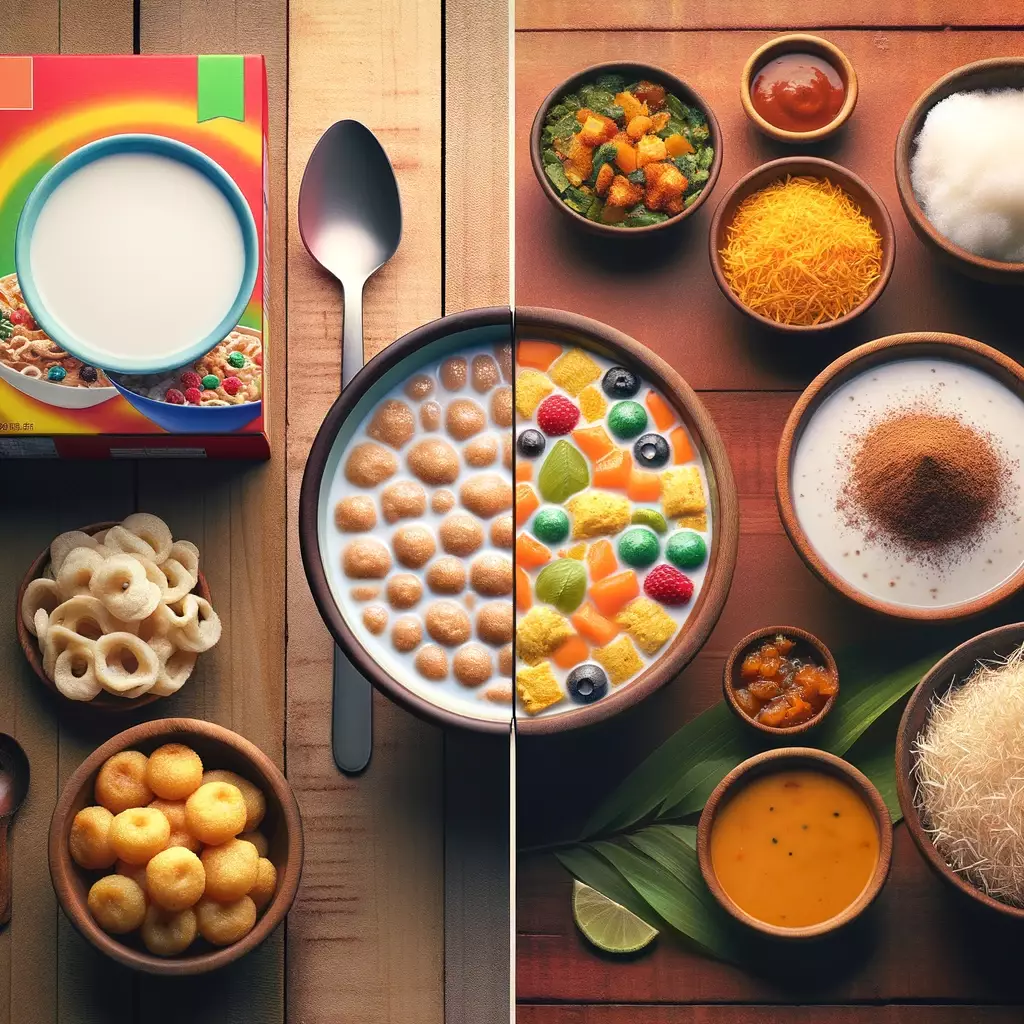What’s Good For Health: Packaged Cereals or Traditional Indian Breakfast?
Breakfast, often hailed as the most important meal of the day, sets the tone for your entire day. It provides the essential nutrients and energy needed to kickstart your morning and keep you going until lunch. In today’s fast-paced world, many people turn to convenient options like packaged cereals for a quick breakfast. However, traditional Indian breakfasts, rich in variety and nutrition, continue to be a staple in many households. This raises a crucial question: What’s better for your health—packaged cereals or traditional Indian breakfast?
In this blog, we will delve into the health benefits and potential drawbacks of both options, helping you make an informed choice that aligns with your health goals.
1. Nutritional Overview
Before diving into specific breakfast options, it’s essential to understand the nutritional components that make up a healthy breakfast. A balanced breakfast typically includes:
- Carbohydrates: Provide energy to start the day.
- Proteins: Help in building and repairing tissues and maintaining muscle mass.
- Fats: Essential for absorbing vitamins and providing long-lasting energy.
- Fiber: Crucial for digestive health.
- Vitamins and Minerals: Support overall health, including immune function, bone health, and energy production.
Let’s explore how packaged cereals and traditional Indian breakfasts measure up against these criteria.

2. The Case for Packaged Cereals
Packaged cereals have become a go-to option for many due to their convenience. They are readily available, require little to no preparation, and are often marketed as a healthy start to the day. But are they really as nutritious as they seem?
2.1 Nutritional Content
- Carbohydrates: Most packaged cereals are high in carbohydrates, primarily in the form of sugars. While they provide a quick energy boost, the high sugar content can lead to a rapid spike in blood sugar levels, followed by a crash, leaving you feeling tired and hungry again soon after eating.
- Proteins: Cereals are generally low in protein. Although some fortified options may contain added protein, they usually don’t meet the protein needs for a balanced breakfast.
- Fats: The fat content in cereals is often low, which might seem like a positive aspect. However, healthy fats are essential for absorbing fat-soluble vitamins (A, D, E, and K) and providing long-lasting energy.
- Fiber: While whole-grain cereals do contain fiber, many commercial brands are made from refined grains, which lose most of their fiber content during processing.
- Vitamins and Minerals: Many cereals are fortified with vitamins and minerals, which is beneficial. However, the bioavailability (how well the body can absorb these nutrients) is often lower in fortified foods compared to naturally occurring vitamins and minerals in whole foods.
2.2 The Good and the Bad
Pros:
- Convenience: Quick and easy to prepare.
- Variety: Wide range of flavors and types.
- Fortification: Often fortified with essential vitamins and minerals.
Cons:
- High Sugar Content: Can contribute to weight gain and increase the risk of type 2 diabetes.
- Low Protein and Fiber: Might not keep you full for long, leading to overeating later in the day.
- Additives: Many cereals contain artificial flavors, colors, and preservatives.
3. The Case for Traditional Indian Breakfast
Traditional Indian breakfasts are rich in diversity, ranging from light and healthy options like idlis and poha to more filling dishes like parathas and dosas. They are often made from whole grains, legumes, and fresh ingredients, which offer numerous health benefits.
3.1 Nutritional Content
- Carbohydrates: Traditional Indian breakfasts are often made from whole grains like rice, wheat, and millets, which provide complex carbohydrates. These carbs break down slowly, providing sustained energy throughout the morning.
- Proteins: Many traditional dishes include legumes (like lentils) or dairy (like paneer or curd), both excellent sources of protein. This makes them more satisfying and supports muscle maintenance and repair.
- Fats: Healthy fats from sources like ghee, coconut, and nuts are commonly used in Indian breakfasts. These fats are essential for brain health and help in absorbing fat-soluble vitamins.
- Fiber: Whole grains, vegetables, and legumes used in traditional breakfasts are high in fiber, which promotes digestive health and helps in maintaining stable blood sugar levels.
- Vitamins and Minerals: Traditional Indian breakfasts often incorporate a variety of vegetables, spices, and herbs, providing a wide range of vitamins, minerals, and antioxidants. These nutrients support overall health and can help in preventing chronic diseases.
3.2 The Good and the Bad
Pros:
- Nutritionally Balanced: Provides a good mix of carbs, protein, fat, fiber, and micronutrients.
- Satiety: Keeps you fuller for longer, preventing mid-morning hunger pangs.
- Natural Ingredients: Uses whole, unprocessed ingredients, reducing the intake of additives and preservatives.
- Cultural Significance: Eating traditional foods can enhance a sense of connection with culture and heritage.
Cons:
- Preparation Time: Requires more time and effort to prepare compared to packaged cereals.
- Portion Control: Some traditional breakfasts can be calorie-dense, so portion control is important.
4. Comparative Analysis: Packaged Cereals vs. Traditional Indian Breakfast
When comparing packaged cereals to traditional Indian breakfasts, it’s clear that both have their own set of advantages and disadvantages. To make a well-informed decision, consider the following factors:
4.1 Nutritional Value
Traditional Indian breakfasts tend to be more nutritionally balanced compared to packaged cereals. They provide complex carbohydrates, proteins, healthy fats, and fiber, which work together to keep you full and energized throughout the morning. Packaged cereals, on the other hand, often lack sufficient protein and fiber and may contain high amounts of sugar and additives.
4.2 Satiety and Energy Levels
Due to their high protein and fiber content, traditional Indian breakfasts are more likely to keep you satisfied until your next meal. Packaged cereals, particularly those high in sugar, can cause a quick spike in energy followed by a crash, leading to mid-morning hunger and potential overeating.
4.3 Convenience vs. Health
Packaged cereals undoubtedly win in terms of convenience. They require no preparation and can be consumed quickly, making them a popular choice for busy mornings. However, this convenience comes at the cost of nutritional value. Traditional Indian breakfasts may require more time to prepare, but they offer superior nutrition and taste.
4.4 Cultural and Psychological Impact
Traditional Indian breakfasts are not just meals; they are a part of cultural heritage. Eating these foods can foster a deeper connection to one’s culture and provide psychological comfort, which is an essential aspect of overall well-being. Packaged cereals, while convenient, lack this cultural significance and emotional connection.

5. Making a Balanced Choice
When deciding between packaged cereals and traditional Indian breakfasts, it’s important to consider your individual lifestyle, health goals, and personal preferences. Here are some tips to help you make a balanced choice:
5.1 If You Choose Packaged Cereals:
- Read Labels Carefully: Look for cereals with whole grains as the first ingredient, minimal added sugars, and no artificial additives.
- Add Protein and Fiber: Pair your cereal with a protein source like Greek yogurt, nuts, or eggs to increase satiety. Adding fruits like berries or a banana can boost the fiber content.
- Portion Control: Stick to the recommended serving size to avoid excess calorie and sugar intake.
5.2 If You Choose Traditional Indian Breakfasts:
- Focus on Balance: Ensure your breakfast includes a balance of carbs, protein, and fats. For example, pair idlis with sambar (which contains lentils) or parathas with curd or paneer.
- Portion Control: Be mindful of portion sizes, especially with calorie-dense options like parathas or poha made with generous amounts of oil or ghee.
- Experiment with Ingredients: Incorporate a variety of grains, vegetables, and proteins to keep your meals interesting and nutritionally diverse.
5.3 A Middle Ground: Combining Both
If you’re short on time but still want the benefits of a traditional breakfast, consider preparing some elements in advance. For example, you can make idli batter the night before or keep boiled eggs and chopped vegetables ready for a quick stir-fry. Alternatively, mix your packaged cereal with traditional ingredients like nuts, seeds, and fresh fruits to enhance its nutritional value.
6. Health Implications of Regularly Consuming Packaged Cereals
While occasional consumption of packaged cereals is unlikely to harm your health, making them a regular part of your diet may have some negative effects, especially if you opt for varieties high in sugar and low in fiber.
6.1 Risk of Obesity and Weight Gain
High sugar content in cereals can contribute to increased calorie intake without providing lasting satiety, leading to overeating and potential weight gain. Over time, this can increase the risk of obesity and related health issues such as heart disease and type 2 diabetes.
6.2 Impact on Blood Sugar Levels
The refined carbohydrates and sugars in many cereals can cause rapid spikes in blood sugar levels, followed by crashes. This pattern can lead to insulin resistance over time, a precursor to type 2 diabetes.
6.3 Lack of Nutritional Variety
Relying too heavily on packaged cereals can result in a monotonous diet lacking in diversity. Traditional Indian breakfasts, with their variety of grains, legumes, and vegetables, offer a broader spectrum of nutrients, which is beneficial for overall health.
7. Health Implications of Regularly Consuming Traditional Indian Breakfasts
Traditional Indian breakfasts, when prepared with wholesome ingredients and in appropriate portions, are generally associated with numerous health benefits. However, it’s important to be mindful of how these meals are prepared.
7.1 Heart Health
Many traditional Indian breakfasts, such as those prepared with millets, whole grains, and legumes, are heart-healthy. They are typically low in unhealthy fats and high in fiber, which can help reduce cholesterol levels and improve cardiovascular health.
7.2 Digestive Health
The fiber content in traditional Indian breakfasts supports healthy digestion and can help prevent constipation. Fermented foods like idlis and dosas also promote gut health by providing beneficial probiotics.
7.3 Sustainable Energy
The complex carbohydrates and proteins in traditional Indian breakfasts provide sustained energy, helping to maintain stable blood sugar levels and reducing the likelihood of mid-morning energy crashes.
8. Conclusion: What’s Best for Your Health?
When it comes to choosing between packaged cereals and traditional Indian breakfasts, traditional options generally offer superior nutrition, better satiety, and a deeper cultural connection. However, the convenience of packaged cereals cannot be denied, especially for those with busy lifestyles.
The best approach may be to incorporate both options in a balanced way, leaning more towards traditional breakfasts when time permits and choosing healthier cereal options when in a rush. By being mindful of ingredients, portion sizes, and nutritional balance, you can make breakfast a powerful tool in maintaining your health and well-being.
Final Thought: Your breakfast choice is a personal one, influenced by factors like time, taste preferences, and nutritional needs. Whether you lean towards the convenience of cereals or the wholesomeness of traditional Indian breakfasts, the key is to listen to your body and nourish it in a way that supports your long-term health.




